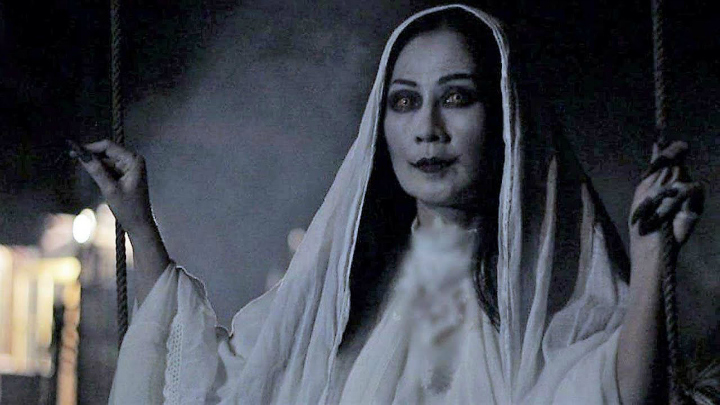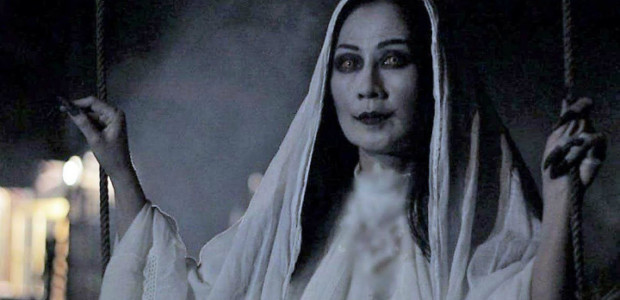Existing somewhere in that wide-open territory between a near-miss and an extraordinary miscalculation, SATAN’S SLAVES is the kind of movie you want to like—a lot—and then ends up, well, not quite breaking your heart. And the reason it doesn’t make it all the way there is that it doesn’t really try hard enough to win your heart in the first place.
A loose remake of a famous 1982 release, the film looks more than promising on paper considering that Indonesian auteur Joko Anwar is at the helm. In fact, the situation is kind of like Luca Guadagnino remaking SUSPIRIA in terms of marrying a very solid director and a definite stylist to genre content from the glory days of grindhouse cinema. Add to this the aesthetically neat choice of setting the story back in 1981, the film’s willingness to get to the creepy stuff early and often, and the fact that it was the top-grossing film in Indonesia in 2017, and you can see why it was booked for Cinepocalypse 2018.
Also to its credit, SATAN’S SLAVES features pacing that allows about 45 minutes to pass before the central conflict or plot dynamic is revealed. That means those first 45 minutes are filled with atmosphere, mystery, and a generally effective buildup. They also feature Anwar, a true master, adapting his strengths to the retro material to produce some nice sequences. Arguably no one gets as much mileage from nothing really happening, and actually from barely even anything being shown. Bare walls, hallways, and floorboards all look ominous through his eyes and through the lens of DP Ical Tanjung. And there’s one terrific jump scare that’s so simply yet cleverly orchestrated you’ll be a bit embarrassed you fell for it.

The problem is that eventually all these tropes and techniques both repeat themselves and get supplemented by decidedly less original variations. Sadly, it soon starts to feels that Anwar has chained himself to a vehicle that owns him rather than vice versa: it doesn’t allow him to be himself at some point, and the result is second-rate POLTERGEIST-like family horror crossed with a generic siege movie that never gets off the ground. Sure, a closing credits sequence demonstrates the director’s lyricism and knack for portraying evil, but by then it’s a case of too little, waaay too late. A huge missed opportunity has already taken place. In a way, then, this effort makes me mindful of both Adam Wingard and Lucky McKee, two distinct voices in horror whose work I always looked forward to but who gradually got in the habit of turning out conventional and largely disappointing work.
On top of the conventionality SATAN’S SLAVES comes to indulge in, there’s a general lack of care that’s maybe the most disturbing thing about the film. At one point the protagonist has her out-of-frame arm attacked while it extends through an open window. Yes, that old bit. Except we never get the payoff of seeing what happened to her arm—is it mangled, just scratched, covered in something gross?—nor do we see whatever was responsible for grabbing her. It’s one of many fillers, time- and tension-wasters really. Another more laughable example concerns a young boy being drawn from a room by an indoor wind exerting so much suction that he’s horizontal, holding onto a doorframe for dear life. Yep, the movie goes there, and without any awareness that we’ve seen this a thousand times before or any inclination to do anything new with the idea. Adding injury to insult, the director and editor don’t seem to mind that the boy is clearly not using anything but the very faintest of pressure in his fingertips to keep from flying off, and that for a split-second one can even see that there’s no contact at all with the doorframe.

This lack of care indicates an overall laziness, and has got to be a little off-putting to what one presumes is the target audience. As if the atmospherics alone could be used as a form of shorthand to avoid the heavy lifting. They can’t. The craft and emotional intelligence must be there throughout, and when we have characters dying and no one seems to react or really mourn—and this isn’t done as a form of intentional bleakness or dark humor—then we’ve reached the emotionally threadbare approach of much Hollywood horror. Instead, there’s a false earnestness that tries to persuade us rather mechanically that the characters care about each other. To this end, much of the truly awkward blocking and subpar child acting revolves around the cast comforting and protecting each other. And no, none of this is remotely close to so-bad-it’s-good.
Instead, the result, especially when the tired tropes are considered as well, is like a self-parody of all the James Wan-inspired movies rolled into one: THE INSIDIOUS CONJURING, PART 38: THIS TIME IT’S IN INDONESIA. Couple this with the clichés of “Asian horror”—the long-haired female specter, the general incoherence of the scares—without anything new added, and by the time the film anticlimaxes you’ve experienced a mini-disaster. Some of this negativity might be mitigated by watching SATAN’S SLAVES in a packed theater with an audience motivated to view its weaknesses as mere “cheesiness.” Just be forewarned that in such cases your commitment to make the film fun could outweigh that of the filmmakers.


No Comments